Research on Fluid–Solid Coupling Mechanism around Openhole Wellbore under Transient Seepage Conditions
Abstract
1. Introduction
2. Numerical Methodology
2.1. Fluid–Solid Coupling Model
2.2. Model Validation
2.2.1. Pore Pressure Field Verification
2.2.2. Effective Stress Field Verification
3. Numerical Results
3.1. Evolution Characteristics of Pore Pressure Field and Effective Stress Field
3.2. Influence of Seepage Parameters
3.3. Influence of Reservoir Parameters
4. Conclusions
Author Contributions
Funding
Informed Consent Statement
Data Availability Statement
Conflicts of Interest
References
- Hasan, M.M.F.; First, E.L.; Boukouvala, F.; Floudas, C.A. A multi-scale framework for CO2 capture, utilization, and sequestration: CCUS and CCU. Comput. Chem. Eng. 2015, 81, 2–21. [Google Scholar] [CrossRef]
- Jiang, K.; Ashworth, P.; Zhang, S.; Liang, X.; Sun, Y.; Angus, D. China’s carbon capture, utilization and storage (CCUS) policy: A critical review. Renew. Sustain. Energy Rev. 2020, 119, 109601. [Google Scholar] [CrossRef]
- Pan, L.; Oldenburg, C.; Pruess, K.; Wu, Y.-S. Transient CO2 leakage and injection in wellbore-reservoir systems for geologic carbon sequestration. Greenh. Gases Sci. Technol. 2011, 1, 335–350. [Google Scholar] [CrossRef]
- Zhu, H.; Deng, J.; Jin, X.; Hu, L.; Luo, B. Hydraulic Fracture Initiation and Propagation from Wellbore with Oriented Perforation. Rock Mech. Rock Eng. 2015, 48, 585–601. [Google Scholar] [CrossRef]
- Zhou, D.; Wang, H.; He, Z.; Liu, Y.; Liu, S.; Ma, X.; Cai, W.; Bao, J. Numerical study of the influence of seepage force on the stress field around a vertical wellbore. Eng. Appl. Comput. Fluid Mech. 2020, 14, 1489–1500. [Google Scholar] [CrossRef]
- Wang, H.; Zhou, D.; Liu, S.; Wang, X.; Ma, X.; Yao, T. Hydraulic fracture initiation for perforated wellbore coupled with the effect of fluid seepage. Energy Rep. 2022, 8, 10290–10298. [Google Scholar] [CrossRef]
- Roy, P.; Morris, J.P.; Walsh, S.D.C.; Iyer, J.; Carroll, S. Effect of thermal stress on wellbore integrity during CO2 injection. Int. J. Greenh. Gas Control 2018, 77, 14–26. [Google Scholar] [CrossRef]
- Haimson, B.; Fairhurst, C. Initiation and Extension of Hydraulic Fractures in Rocks. Soc. Pet. Eng. J. 1967, 7, 310–318. [Google Scholar] [CrossRef]
- Haimson, B.C. Hydraulic Fracturing in Porus and Nonporus Rock and Its Potential for Determining In-Situ Stresses at Great Depth; University of Minnesota: Minneapolis, MN, USA, 1968. [Google Scholar]
- Haimson, B.; Fairhurst, C. Hydraulic Fracturing in Porous-Permeable Materials. J. Pet. Technol. 1969, 21, 811–817. [Google Scholar] [CrossRef]
- Hubbert, M.K.; Willis, D.G. Mechanics of Hydraulic Fracturing. Trans. AIME 1957, 210, 153–168. [Google Scholar] [CrossRef]
- Reisabadi, M.Z.; Haghighi, M.; Sayyafzadeh, M.; Khaksar, A. Effect of matrix shrinkage on wellbore stresses in coal seam gas: An example from Bowen Basin, east Australia. J. Nat. Gas Sci. Eng. 2020, 77, 103280. [Google Scholar] [CrossRef]
- Li, Y.; Cheng, Y.; Yan, C.; Song, L.; Liu, H.; Tian, W.; Ren, X. Mechanical study on the wellbore stability of horizontal wells in natural gas hydrate reservoirs. J. Nat. Gas Sci. Eng. 2020, 79, 103359. [Google Scholar] [CrossRef]
- Ren, K.; Cai, C. Numerical Investigation into the Distributions of Temperature and Stress around Wellbore during the Injection of Cryogenic Liquid Nitrogen into Hot Dry Rock Reservoir. Math. Probl. Eng. 2021, 2021, 9913321. [Google Scholar] [CrossRef]
- Jafari Raad, S.M.; Lawton, D.; Maidment, G.; Hassanzadeh, H. Transient non-isothermal coupled wellbore-reservoir modeling of CO2 injection—Application to CO2 injection tests at the CaMI FRS site, Alberta, Canada. Int. J. Greenh. Gas Control 2021, 111, 103462. [Google Scholar] [CrossRef]
- Qiu, Y.; Ma, T.; Liu, J.; Peng, N.; Ranjith, P.G. Poroelastic response of inclined wellbore geometry in anisotropic dual-medium/media. Int. J. Rock Mech. Min. Sci. 2023, 170, 105560. [Google Scholar] [CrossRef]
- Xiao, H.; Li, W.; Wang, Z.; Yang, S.; Tan, P. Critical Conditions for Wellbore Failure during CO2-ECBM Considering Sorption Stress. Sustainability 2023, 15, 3696. [Google Scholar] [CrossRef]
- Rim, H.; Chen, Y.; Tokgo, J.; Du, X.; Li, Y.; Wang, S. Time-Dependent Effect of Seepage Force on Initiation of Hydraulic Fracture around a Vertical Wellbore. Materials 2023, 16, 2012. [Google Scholar] [CrossRef]
- Hou, L.; Zhou, L.; Elsworth, D.; Wang, S.; Wang, W. Prediction of Fracturing Pressure and Parameter Evaluations at Field Practical Scales. Rock Mech. Rock Eng. 2024, 1–14. [Google Scholar] [CrossRef]
- Hossain, M.M.; Rahman, M.K.; Rahman, S.S. Hydraulic fracture initiation and propagation: Roles of wellbore trajectory, perforation and stress regimes. J. Pet. Sci. Eng. 2000, 27, 129–149. [Google Scholar] [CrossRef]
- Fallahzadeh, S.H.; Shadizadeh, S.R.; Pourafshary, P. Dealing with the Challenges of Hydraulic Fracture Initiation in Deviated-Cased Perforated Boreholes. In Proceedings of the Trinidad and Tobago Energy Resources Conference, Port of Spain, Trinidad and Tobago, 27–30 June 2010. [Google Scholar]
- Ding, Y.; Liu, X.; Luo, P. The analytical model of hydraulic fracture initiation for perforated borehole in fractured formation. J. Pet. Sci. Eng. 2018, 162, 502–512. [Google Scholar] [CrossRef]
- Wang, H.Y.; Zhou, D.S.; Gao, Q.; Fan, X.; Xu, J.Z.; Liu, S. Study on the Seepage Force-Induced Stress and Poroelastic Stress by Flow Through Porous Media Around a Vertical Wellbore. Int. J. Appl. Mech. 2021, 13, 2150065. [Google Scholar] [CrossRef]
- Biot, M.A. General theory of three-dimensional consolidation. J. Appl. Phys. 1941, 12, 155–164. [Google Scholar] [CrossRef]
- Rice, J.R.; Cleary, M.P. Some basic stress diffusion solutions for fluid-saturated elastic porous media with compressible constituents. Rev. Geophys. 1976, 14, 227–241. [Google Scholar] [CrossRef]
- Geertsma, J. Problems of Rock Mechanics in Petroleum Production Engineering. In Proceedings of the 1st ISRM Congress, Lisbon, Portugal, 25 September–1 October 1966. [Google Scholar]
- Yew, C.H.; Liu, G. Pore Fluid and Wellbore Stabilities. In Proceedings of the International Meeting on Petroleum Engineering, Beijing, China, 24–27 March 1992. [Google Scholar]
- Ito, T. Effect of pore pressure gradient on fracture initiation in fluid saturated porous media: Rock. Eng. Fract. Mech. Eng. Fract. Mech. 2008, 75, 1753–1762. [Google Scholar] [CrossRef]
- Wang, H.; Zhou, D. Mechanistic study on the effect of seepage force on hydraulic fracture initiation. Fatigue Fract. Eng. Mater. Struct. 2024. [Google Scholar] [CrossRef]
- Carslaw, H.S.; Jaeger, J.C. Conduction of Heat in Solids; Clarendon Press: Oxford, UK, 1959; pp. 314–332. [Google Scholar]
- Terzaghi, K.; Peck, R.B.; Mesri, G. Soil Mechanics in Engineering Practice, 3rd ed.; John Wiley: New York, NY, USA, 1995; 750p. [Google Scholar]
- Chen, X.; Li, Y.; Liu, Z.; Tang, Y.; Sui, M. Visualized investigation of the immiscible displacement: Influencing factors, improved method, and EOR effect. Fuel 2023, 331, 125841. [Google Scholar] [CrossRef]
- Hou, L.; Ren, J.; Fang, Y.; Cheng, Y. Data-driven optimization of brittleness index for hydraulic fracturing. Int. J. Rock Mech. Min. Sci. 2022, 159, 105207. [Google Scholar] [CrossRef]
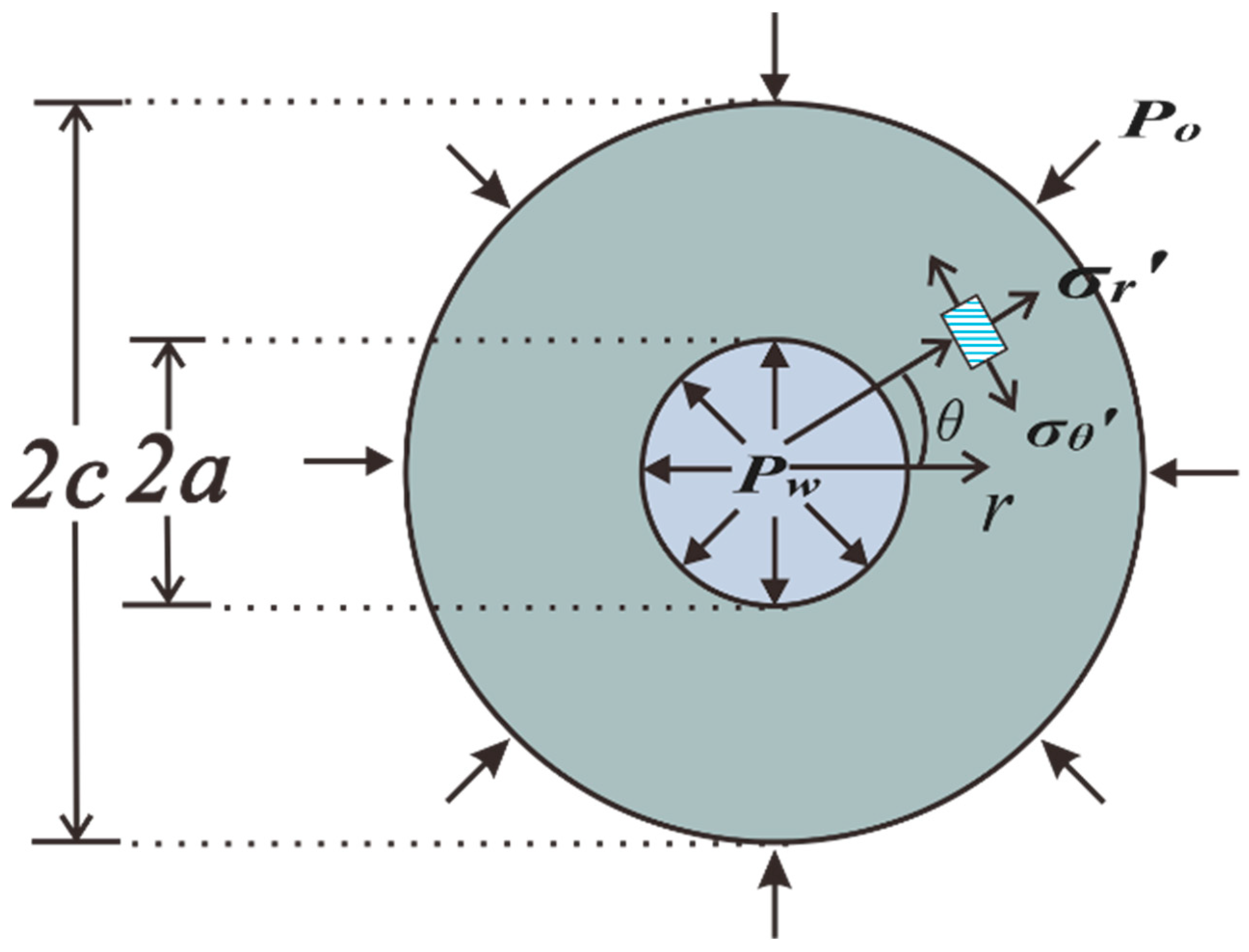


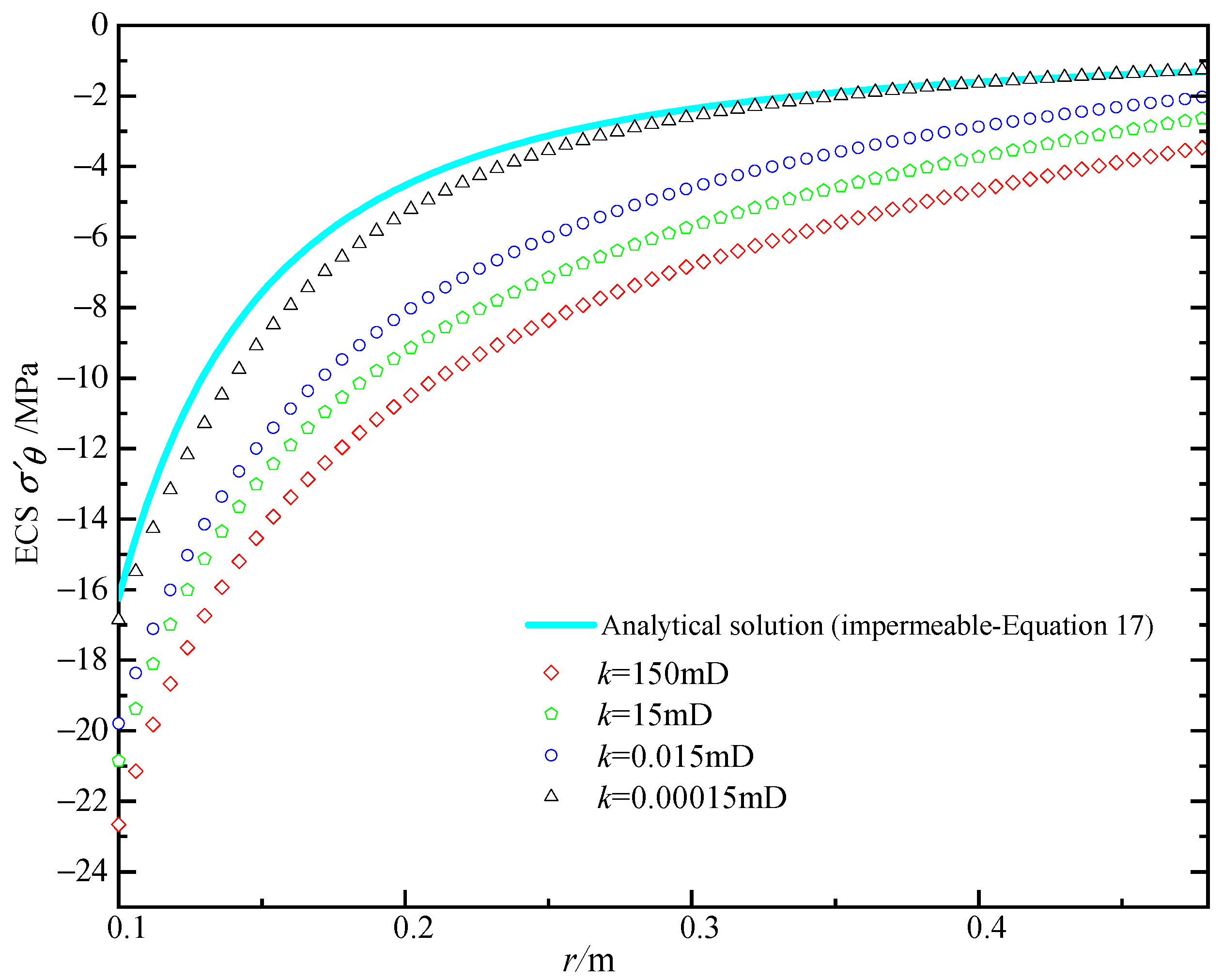
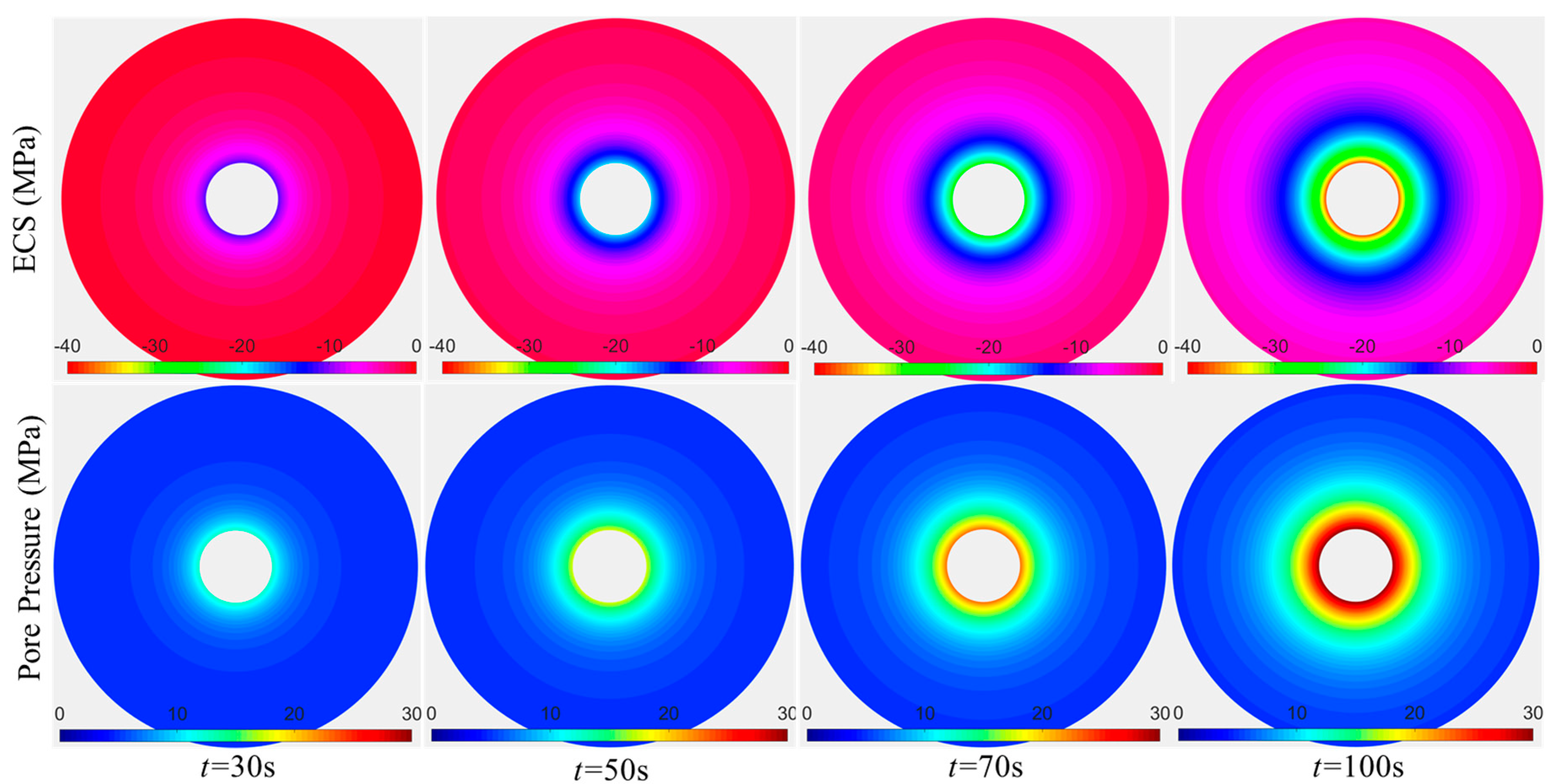
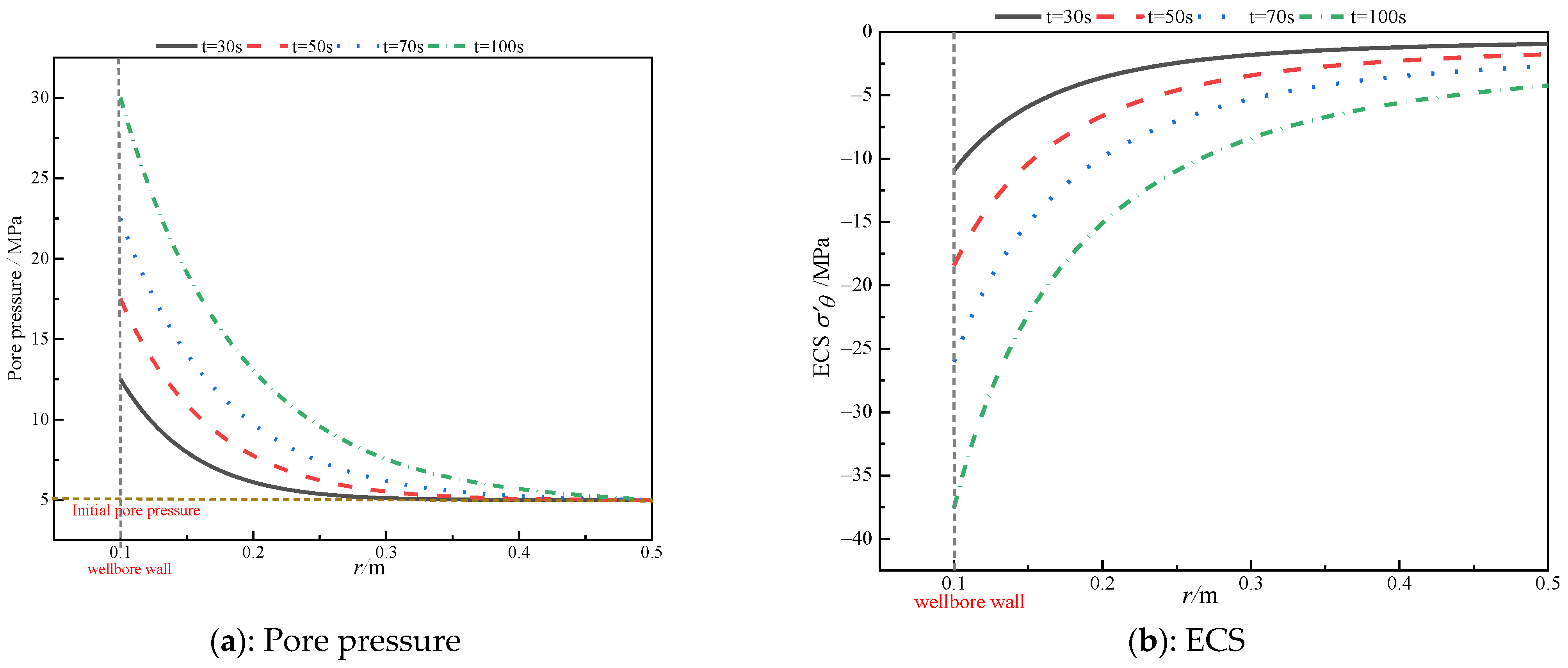
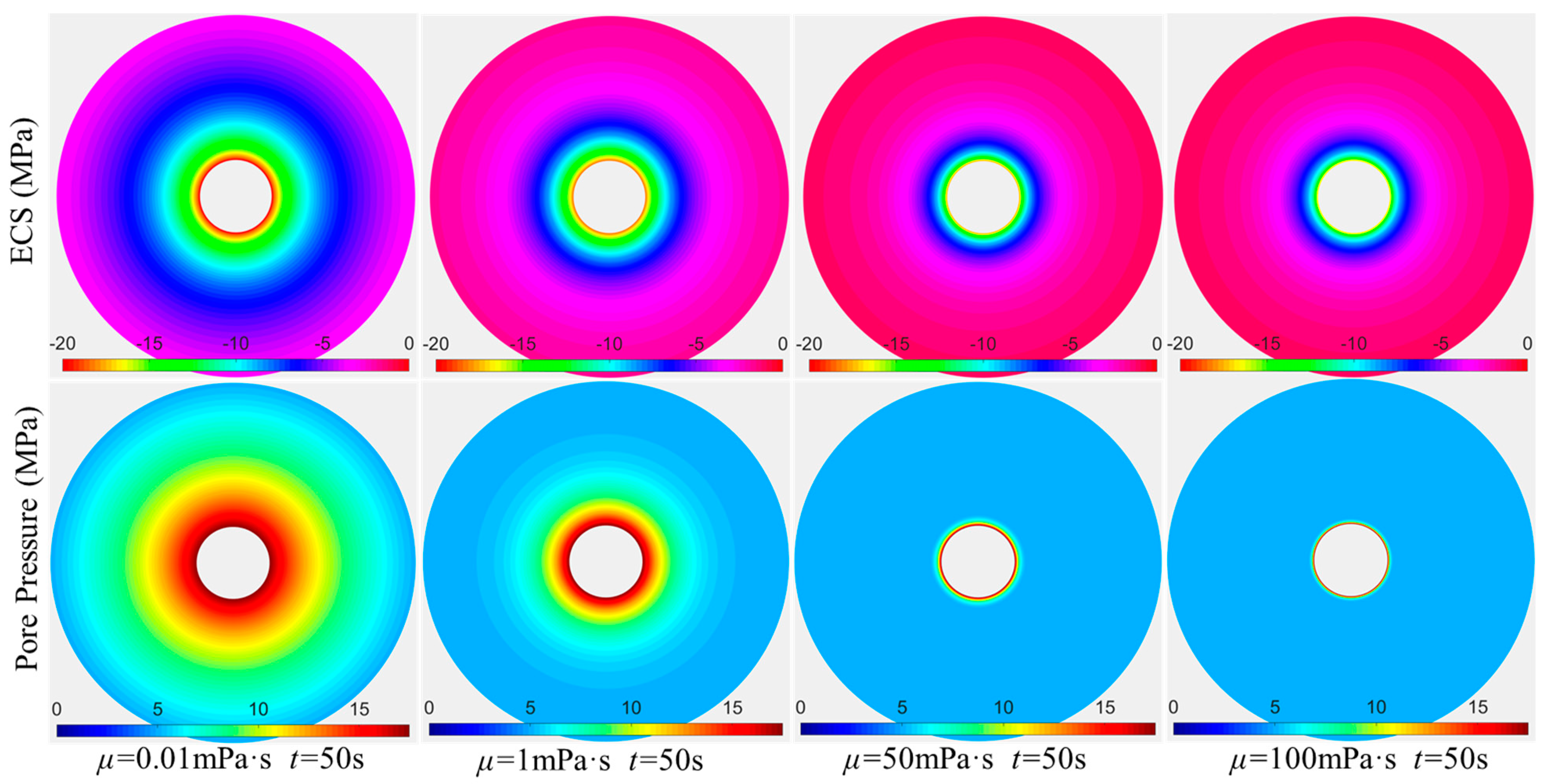


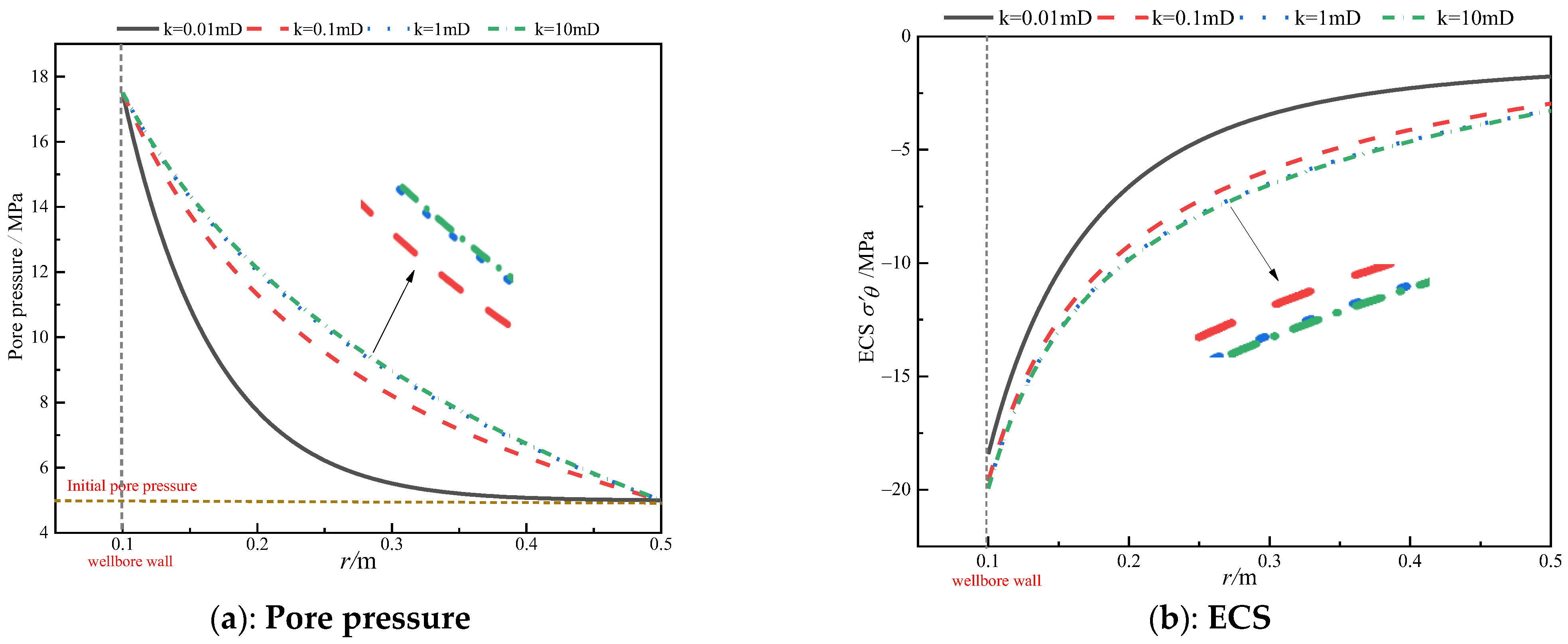
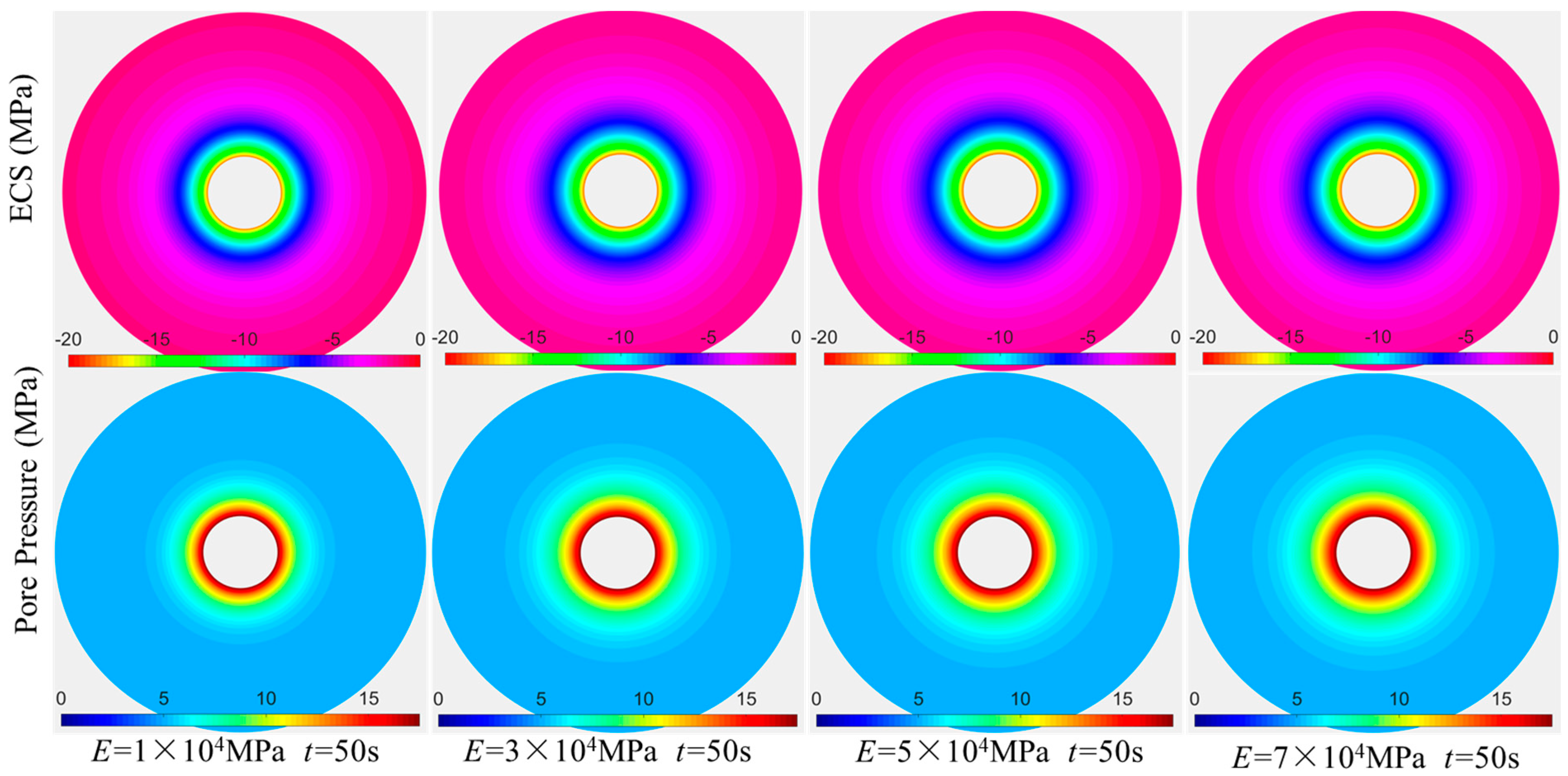
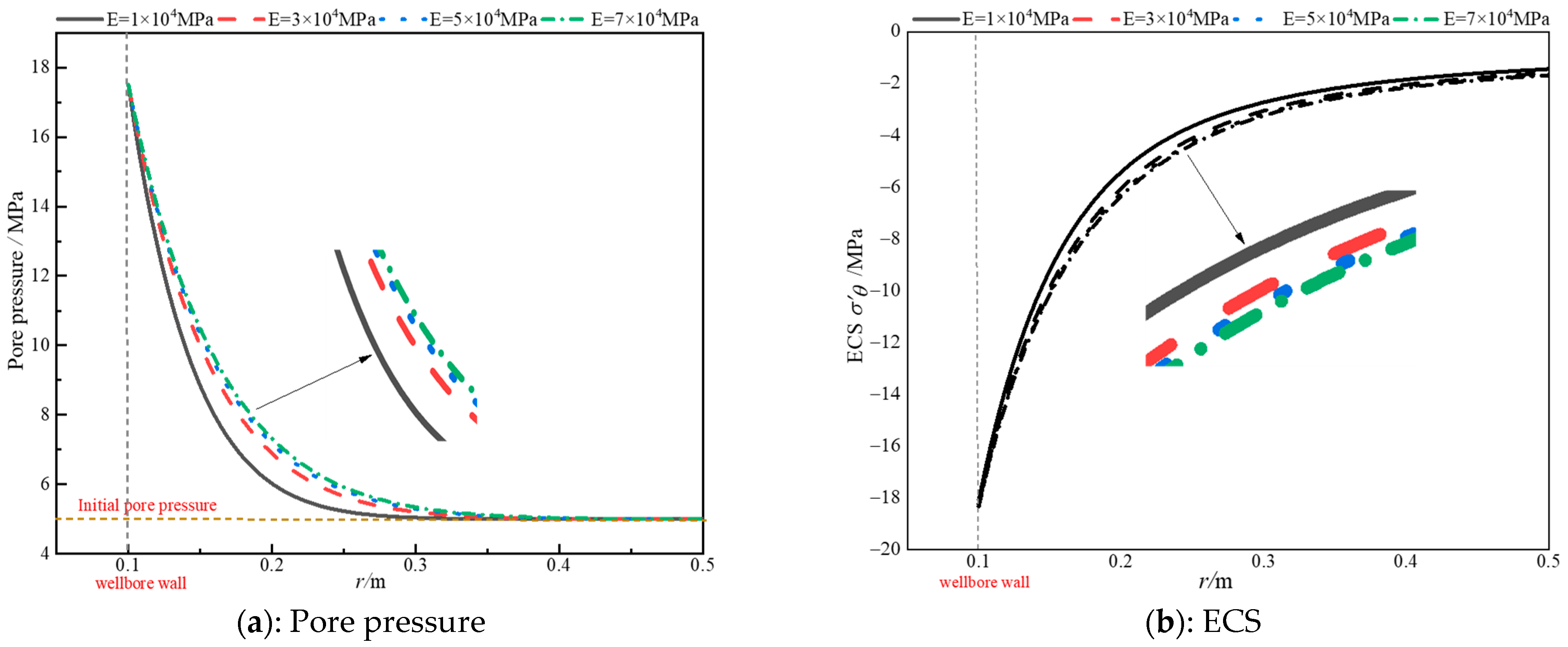

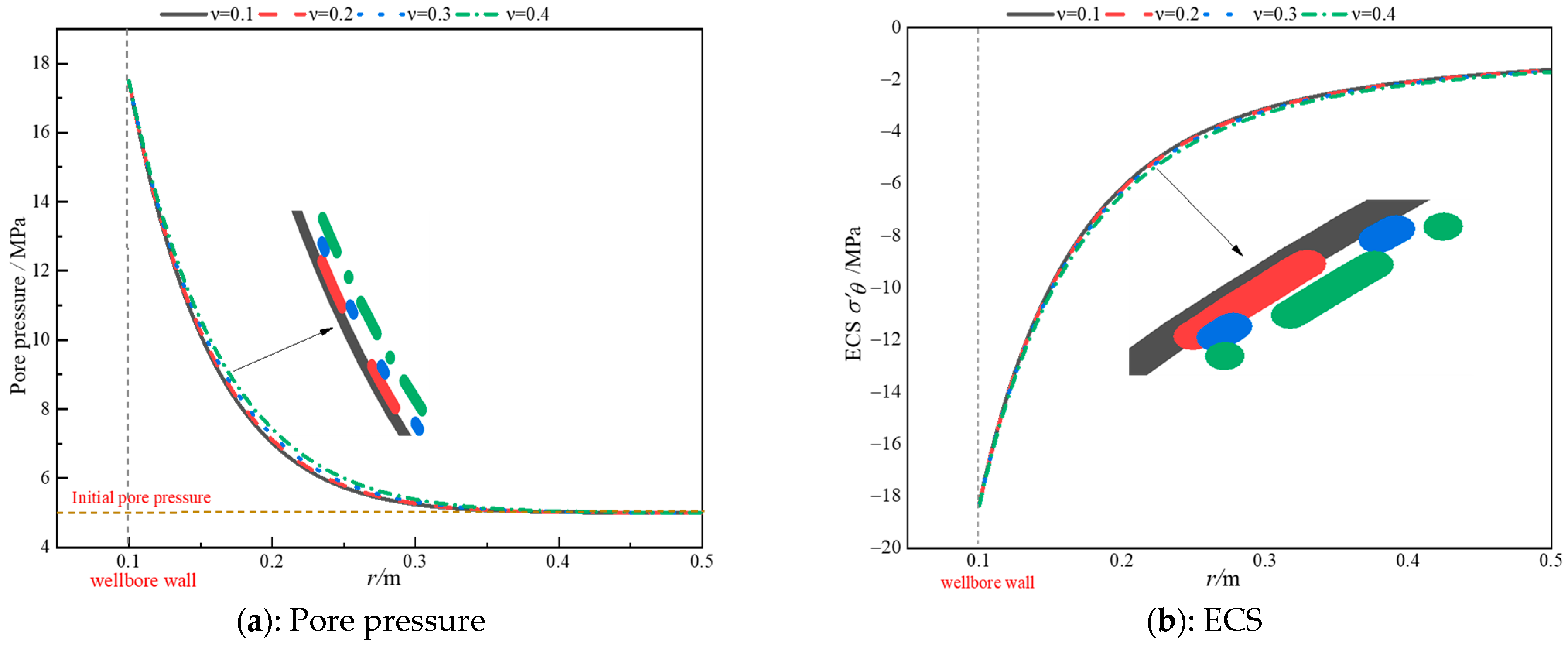
Disclaimer/Publisher’s Note: The statements, opinions and data contained in all publications are solely those of the individual author(s) and contributor(s) and not of MDPI and/or the editor(s). MDPI and/or the editor(s) disclaim responsibility for any injury to people or property resulting from any ideas, methods, instructions or products referred to in the content. |
© 2024 by the authors. Licensee MDPI, Basel, Switzerland. This article is an open access article distributed under the terms and conditions of the Creative Commons Attribution (CC BY) license (https://creativecommons.org/licenses/by/4.0/).
Share and Cite
Liu, E.; Zhou, D.; Su, X.; Wang, H.; Liu, X.; Xu, J. Research on Fluid–Solid Coupling Mechanism around Openhole Wellbore under Transient Seepage Conditions. Processes 2024, 12, 412. https://doi.org/10.3390/pr12020412
Liu E, Zhou D, Su X, Wang H, Liu X, Xu J. Research on Fluid–Solid Coupling Mechanism around Openhole Wellbore under Transient Seepage Conditions. Processes. 2024; 12(2):412. https://doi.org/10.3390/pr12020412
Chicago/Turabian StyleLiu, Erhu, Desheng Zhou, Xu Su, Haiyang Wang, Xiong Liu, and Jinze Xu. 2024. "Research on Fluid–Solid Coupling Mechanism around Openhole Wellbore under Transient Seepage Conditions" Processes 12, no. 2: 412. https://doi.org/10.3390/pr12020412
APA StyleLiu, E., Zhou, D., Su, X., Wang, H., Liu, X., & Xu, J. (2024). Research on Fluid–Solid Coupling Mechanism around Openhole Wellbore under Transient Seepage Conditions. Processes, 12(2), 412. https://doi.org/10.3390/pr12020412






